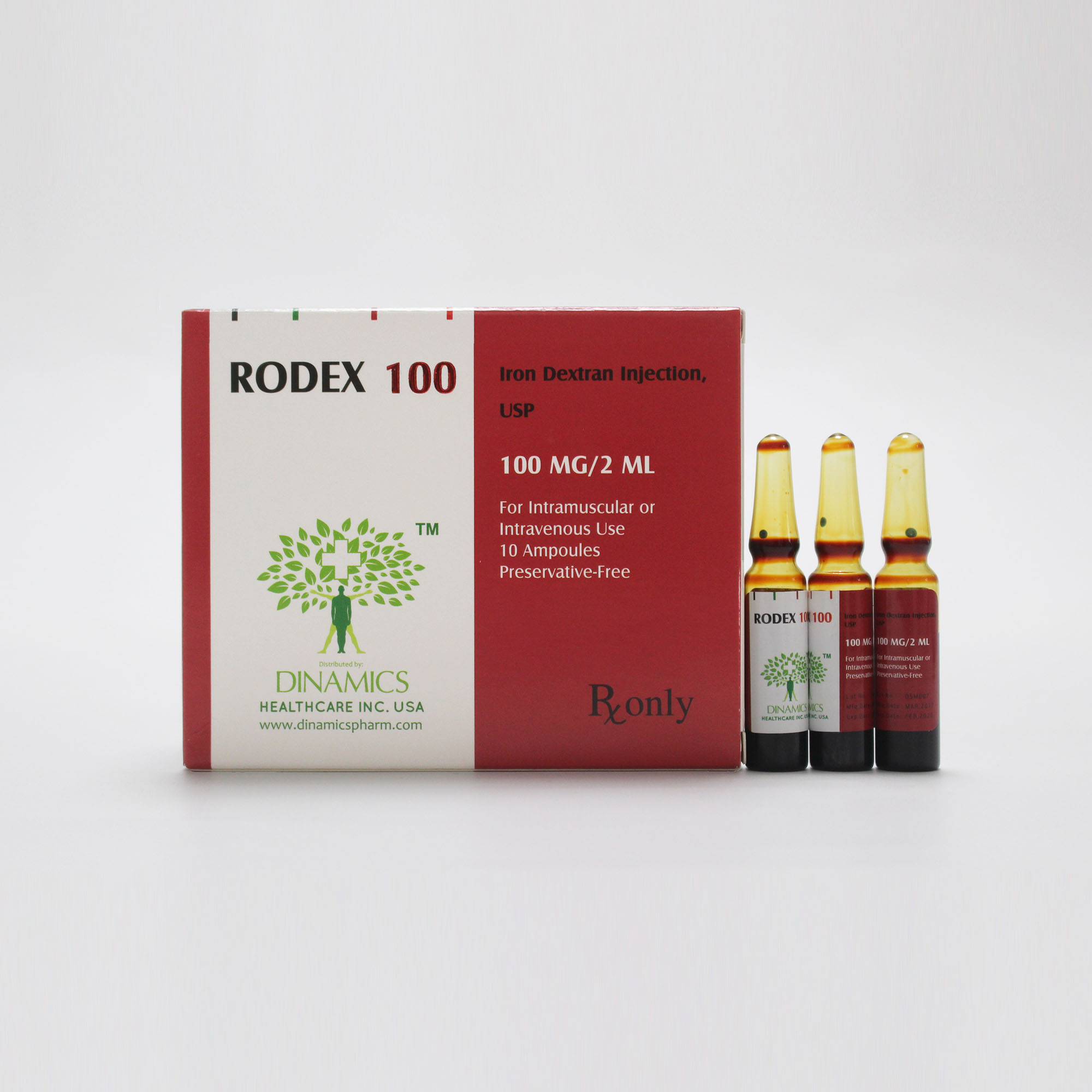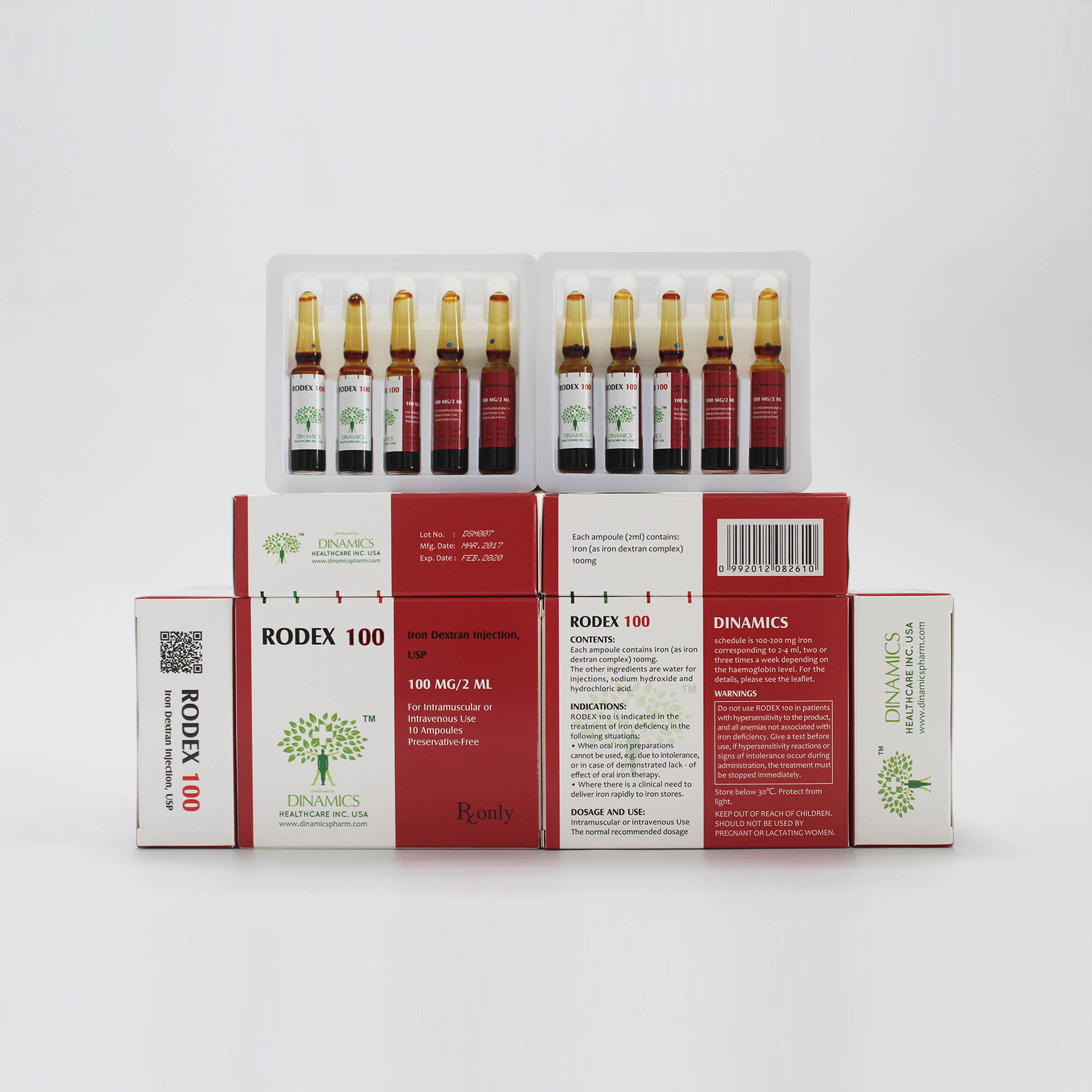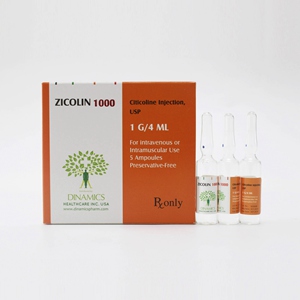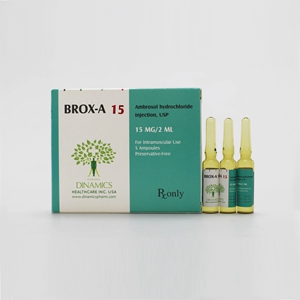1.How to take RODEX 100
RODEX 100 can be administered deep intramuscular injection, intravenous injection or intravenous infusion.
Oral iron should be discontinued prior to administration of RODEX 100. Monitor carefully patients for signs and symptoms of hypersensitivity reactions during and following each administration of RODEX 100.
RODEX 100 should only be administered when staff trained to evaluate and manage anaphylactic reactions is immediately available, in an environment where full resuscitation facilities can be assured. The patient should be observed for adverse effects for at least 30 minutes following each RODEX 100 injection.
Administration:
RODEX 100 can be administered by an intravenous drip infusion or by a slow intravenous injection of which the intravenous drip infusion is the preferred route of administration, as this may help to reduce the risk of hypotensive episodes. However, RODEX 100 may also be administered as undiluted solution intramuscularly.
Adults and elderly
The total cumulative dose of RODEX 100 is determined by haemoglobin level and body weight. The dose and dosage schedule for RODEX 100 must be individually estimated for each patient based on a calculation of the total iron deficit.
Children (under 14 years)
RODEX 100 should not be used for children. There is no documentation for efficacy and safety.
Dosage:
The normal recommended dosage schedule is 100-200 mg iron corresponding to 2-4 ml, two or three times a week depending on the haemoglobin level. However, if clinical circumstances require rapid delivery of iron to the body iron stores RODEX 100 may be administered as a total dose infusion up to a total replacement dose corresponding to 20 mg iron/kg body weight.
RODEX 100 should not be administered concomitantly with oral iron preparations as the absorption of oral iron will be reduced.
Intravenous drip infusion:
RODEX 100 must be diluted only in 0.9% sodium chloride solution (normal saline) or in 5% glucose solution. RODEX 100 in a dose of 100-200 mg iron (2-4ml) may be diluted in 100 ml. On each occasion the first 25 mg of iron should be infused over a period of 15 minutes. If no adverse reactions occur during this time the remaining portion of the infusion should be given at an infusion rate of not more than 100 ml in 30 minutes.
Intravenous injection:
RODEX 100 may be administered in a dose of 100 – 200 mg iron (2-4 ml) by slow intravenous injection (0.2 ml/min) preferably diluted in 10 – 20 ml 0.9% sodium chloride or 5% glucose solution. On each occasion before administering a slow intravenous injection, 25 mg of iron should be injected slowly over a period of 1 to 2 minutes. If no adverse reactions occur within 15 minutes, the remaining portion of the injection may be given.
Total dose infusion:
Immediately before administration the total amount of RODEX 100 required, determined from the dosage table or by calculation, is added aseptically to the required volume, usually 500 ml of sterile normal sodium chloride or 5% glucose solutions. The total amount of RODEX 100, up to 20 mg/kg bodyweight, is infused intravenously over 4-6 hours. The first 25 mg of iron should be infused over a period of 15 minutes. The patient must be kept under close medical observation during this period. If no adverse reactions occur during this time, then the remaining portion of the infusion should be given. The rate of infusion may be increased progressively to 45-60 drops per minute. Patients should be observed carefully during the infusion and for at least 30 minutes after completion.
Total Dose Infusion (TDI) has been associated with an increased incidence of adverse reactions, in particular delayed hypersensitivity–like reactions. The intravenous administration of RODEX 100 by the total dose infusion method should be restricted to hospital use only.
Intramuscular injection:
The total amount of RODEX 100 required is determined either from the dosage table or by calculation. It is administered as a series of undiluted injections of up to 100 mg iron (2.0 ml) each determined by the patient's body weight. If the patient is moderately active, injections may be given daily into alternate buttocks. In inactive or bedridden patients, the frequency of injections should be reduced to once or twice weekly.
RODEX 100 must be given by deep intramuscular injection to minimise the risk of subcutaneous staining. It should be injected only into the muscle mass of the upper outer quadrant of the buttock - never into the arm or other exposed areas. A 20 - 21 gauge needle at least 50 mm long should be used for normal adults. For obese patients the length should be 80 - 100 mm whereas for small adults a shorter and smaller needle (23 gauge×32 mm) is used. The patient should be lying in the lateral position with the injection site uppermost, or standing bearing their weight on the leg opposite the injection site. To avoid injection or leakage into the subcutaneous tissue, a Z-track technique (displacement of the skin laterally prior to injection) is recommended. RODEX 100 is injected slowly and smoothly. It is important to wait for a few seconds before withdrawing the needle to allow the muscle mass to accommodate the injection volume. To minimise leakage up the injection track, the patient should be encouraged not to rub the injection site.
Calculation of dose:
a) Iron replacement in patients with iron deficiency anaemia:
Factors contributing to the formula are shown below. The required dose has to be individually adapted according to the total iron deficit calculated by the following formula – haemoglobin in g/l or mmol/l.
Total dose (mg Fe) – Hb in g/l:
|
Haemoglobin
|
60 g/l ≈
|
75 g/l ≈
|
90 g/l ≈
|
105 g/l ≈
|
120 g/l ≈
|
135 g/l ≈
|
|
content Body
|
3.7 mmol/l
|
4.7 mmol/l
|
5.6 mmol/l
|
6.5 mmol/l
|
7.4 mmol/l
|
8.4 mmol/l
|
|
weight (kg)
|
|
|
|
|
|
|
|
|
|
|
|
|
|
|
|
|
|
|
|
|
|
|
|
35
|
25
|
23
|
20
|
18
|
15
|
12.5
|
|
40
|
27
|
24
|
22
|
19
|
16
|
13
|
|
45
|
29
|
26
|
23
|
20
|
16.5
|
13
|
|
50
|
32
|
28
|
24
|
21
|
17
|
13.5
|
|
|
|
|
|
|
|
|
|
55
|
34
|
30
|
26
|
22
|
18
|
14
|
|
|
|
|
|
|
|
|
|
60
|
36
|
32
|
27
|
23
|
18.5
|
14.5
|
|
65
|
38
|
33
|
29
|
24
|
19.5
|
14.5
|
|
|
|
|
|
|
|
|
|
70
|
40
|
35
|
30
|
25
|
20
|
15
|
|
|
|
|
|
|
|
|
|
75
|
42
|
37
|
32
|
26
|
21
|
15.5
|
|
80
|
45
|
39
|
33
|
27
|
21.5
|
16
|
|
|
|
|
|
|
|
|
|
85
|
47
|
41
|
34
|
28
|
22
|
16
|
|
|
|
|
|
|
|
|
|
90
|
49
|
42
|
36
|
29
|
23
|
16.5
|
Note: The table and accompanying formula are applicable for dose determination only in patients with iron deficiency anaemia. They are not to be used for dose determination in patients requiring iron replacement for blood loss.
b) Iron replacement for blood loss:
Iron therapy in patients with blood loss should be directed toward replacement of an amount of iron equivalent to the amount of iron represented in the blood loss. The table and formula described are not applicable for simple iron replacement values. Quantitative estimates of the individual's periodic blood loss and hematocrit during the bleeding episode provide a convenient method of calculation of the required iron dose.
The required RODEX 100 dose to compensate the iron deficit is calculated according to the following formulas:
• If the volume of blood lost is known: The administration of 200 mg i.v. iron (4 ml RODEX 100) results in an increase of haemoglobin which is equivalent to 1 unit blood (= 400 ml with 150 g/l Hb content or 9.3 mmol Hb/l – equivalent to 0.34% of 0.4×150 or 204 mg iron).
Iron to be replaced [mg] = number of blood units lost × 200. Millilitres of RODEX 100 needed = number of blood units lost × 4.
• If the Hb level is reduced: Use the previous formula considering that the depot iron does not need to be restored.
Mg iron to be replaced = body weight (kg) × 0.24 × (target Hb in g/l - actual Hb in g/l). Or
Mg iron to be replaced = body weight (kg) × 3.84 × (target Hb in mmol/l – actual Hb in mmol/l).
E.g.: body weight 60 kg, Hb deficit = 10 g/l or 0.62 mmol/l:
Iron to be replaced = 60 × 0.24 × 10 = 60 × 3.84 × 0.62 = 143 mg (≈ 3 millilitres RODEX 100)
4. Possible side effects
Like all medicines, RODEX 100 can cause side effects, although not everybody gets them. The following side effects may happen with this medicine.
Allergic reactions (affecting less than 1 in 100 people)
If you have an allergic reaction to RODEX 100 tell your doctor or nurse straight away so that they can stop it if necessary. The signs of this may include:
•shortness of breath
•nettle rash or hives, flushing, rashes, itching
•nausea and shivering.
More serious allergic reactions, may happen in the first few minutes of having RODEX 100 (affecting less than 1 in 10,000 people). The signs may include:
•sudden onset of difficulty breathing (respiratory difficulty)
•serious problems with your heart and circulation (cardiovascular collapse)
•fatalities have been reported.
Also, there have been reports of delayed allergic reactions, that may happen a few hours or up to four days after being given RODEX 100. The signs may include:
•pain in your joints or muscles
•sometimes a high temperature (fever).
Please contact your doctor if you have any of these signs.
Other side effects include
Uncommon (affecting less than 1 in 100 people):
•pain in and around the stomach (abdominal pain), being sick (vomiting)
•blurred vision
•feeling hot
•cramps
•numbness.
Rare (affecting less than 1 in 1,000 people):
•loss of consciousness
•altered mental status
•seizure (fits)
•dizziness, restlessness, fatigue
•low blood pressure
•angioedema, a type of severe allergic reaction, signs may include swelling
•uneven (irregular) heart beat, high pulse rate, chest pain
•diarrhoea, sweating and tremor.
Very rare (affecting less than 1 in 10,000 people):
•lower red blood cells than usual (this would show up in some blood tests)
•headache
•unusual feeling on the surface of your body
•raised blood pressure
•temporary deafness
•palpitations
•in pregnancy, the baby’s heart rate may slow.
Some other side effects have been reported. People with ‘rheumatoid’ arthritis may have worsening of joint pain.
Possible side effects after an injection into your vein
If you have RODEX 100 into a vein, there may be reactions, such as soreness and swelling (inflammation) around the vein. There have also been reports of inflammation of the vein.
Possible side effects after an injection into your muscle
If you have RODEX 100 into a muscle, there may be reactions, such as staining of the skin, bleeding, formation of boils, tissue damage (necrosis or atrophy) and pain.










